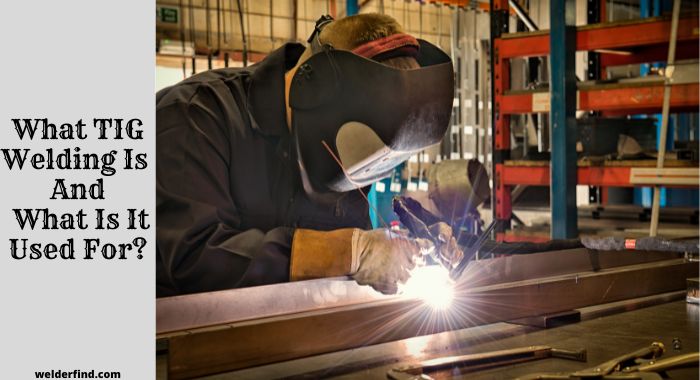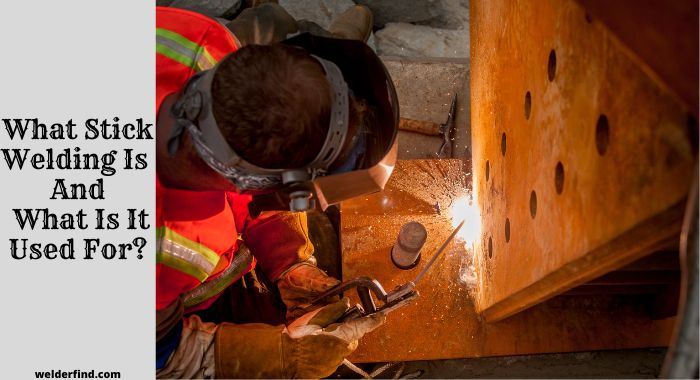Welders often get confused about choosing the proper welding process and end up getting disappointed.
So if you’re in the same dilemma regarding what to pick between Tig vs. Stick Welding, this write-up will come in handy.
Here, I’ll walk you through their basic features, characteristics, and the most noticeable differences between them.
Let’s dive in!
Tig Welding
What TIG Welding Is and What Is It Used For?

In seasoned and beginner welders, Tig, aka inert tungsten gas, is a basic welding method that utilizes “non-consumable” tungsten.
For this process, you’ll need to place an arch between the work piece and electrode (tungsten) to heat them using shielding gas and filler materials.
Let it be stainless steel, steel, aluminum, Chromoly, copper, or magnesium; TIG welding is used for several materials and can work pretty well.
So, welders find it ideal for welding bike frames, wagons, lawnmowers, and so on!
Tig Welding Advantages and Disadvantages
Tig welding has both pros and cons, just like other welding methods. Let me show you what they are:
Advantages:
- The “non-consumable” electrodes it used to assist in offering flawless joints. So unlike consumable electrodes, it won’t require you to stop the welding from replacing the new electrode.
- Tig welding stands out for its versatility as it can weld almost everything, including stainless steel, copper, steel, aluminum, and many more.
- Compared to other welding methods, TIG welding is relatively more controlled and precise. Plus, sparks and spatter won’t annoy you that much.
- TIG welding can be performed both manually and automatically.
- Inert gas is usually molten material, so using flux isn’t needed.
Disadvantages:
- As TIG works slowly, the welding process will be time-consuming.
- The majority of welders find it more complicated, meaning it’s suitable for skilled persons only.
- Inert gas’s rate is relatively higher, which may hurt your wallet.
Why Choose Tig Welding
If you count appearances as one of the key factors, then you must go for TIG welding without thinking twice.
It lets you make a relatively clean weld with a combination of optimal puddle control and arc support.
Moreover, it’s considered precise, versatile, and requires no filler material to get the job done. Feel free to choose TIG welding, as you can operate it both manually and automatically!
Stick Welding
What Stick Welding Is and What It Is Used For?

In most arc-welding procedures, stick welding has been used by many welders for quite a long time.
Basically, it utilizes an anode and electric current, which play a role in joining several metals at once. Hands down, the simplicity of stick welding makes it pretty much popular!
The major uses of stick welding are to weld iron, steel, and such materials. So, you’ll find its usage in repair industries, heavy-steel structures, and construction sites.
Stick Welding Advantages and Disadvantages
Just like Tig welding, stick welding also has some benefits and drawbacks. Some of them are listed below:
Advantages
- Actually, the electrodes of stick welding generate their own shielding gas named CO2 (carbon dioxide), which is why you won’t need any extra gas.
- To perform stick welding, you won’t require lots of equipment.
- Unlike TIG welding, this one offers lower equipment costs, which is a plus for those who are tight on budget.
- When it comes to setup, stick welding is a snap. It doesn’t require fiddling with wire speed, gas flow, hoses, or tungsten.
- You can perform stick welding without sacrificing the weld quality in light rain, high winds, and even in snow.
Disadvantages
- Unlike the TIG, stick welding produces slag, debris, and such things when you weld any metals. So using an extra brush is mandatory for cleaning up.
- Frequent electrode replacement is a common problem you may deal with while welding bigger materials.
- You can’t get weld sheet metals or such thinner components by stick welding easily.
Why Choose Stick Welding?
Do you consider yourself a beginner in the field of welding? If so, then stick welding might be the best way to go! In fact, it won’t require any extra equipment to get the work done.
On top of that, the rate of equipment cost is going to be lower with that, making it more budget-friendly. So rely on it if you cannot break your bank to weld materials.
Tig vs. Stick Welding – A Detailed Comparison
Let’s cut to the chase by showing what things and features make Tig and Stick welding different from each other. Read on the detailed comparison given below:
Weld Strength
The most prominent difference between stick and TIG welding is the level of weld strength. Here, you’ll find each of them pretty strong to withstand heavy heat.
But TIG welding is by far the strongest procedure as it generates extreme heat for joint metal pieces.
That’s why welders find the TIG welding “most suitable” for automotive and heavy-duty machinery projects.
Weld Speed
In welding, speed matters unless you’re a seasoned welder who needs to weld several materials at once. And that’s where the stick welding comes into play; guess why?
This is because the TIG welding works kind of more slowly than the stick as it uses extreme heat to join metals.
So you’ll find the stick welding relatively less time-consuming.
Welding Gas
Here, stick welding will definitely stand out for its excellent capability. Yes, unlike TIG welding, it doesn’t require any specific shielding gas as its electrodes itself produce CO2.
However, for better functionality, many welders these days have been using extra helium, argon, propane, and other fuel gases during stick welding. Similarly, TIG welding prefers utilizing argon and helium particularly.
Weld Able Metals
Honestly speaking, stick welding can’t beat the TIG in terms of versatility.
Ask why because the inert tungsten gas can weld almost everything you prefer, including stainless steel, copper, aluminum, steel, magnesium, and many more.
Although stick welding can be used for several welding applications, it still has some limitations.
For example, it’s worst to rely on stick weld for carbon steel, titanium, and copper in terms of welding these three materials!
Difficulty
Although both stick and TIG welding require you to learn the basics, stick welding is easier because it won’t require any extra equipment to perform, while TIG needs skill.
Electrode
In a word, TIG uses non-consumable “tungsten inter gas” electrodes. In contrast, some of the common electrodes of stick welding are 7024, 7018, 6013, 6010, and 6011. Each serves different characteristics and benefits.
Last Words
That wasn’t a race between hare and tortoise because each has unique specialties and some limitations.
So, compared to Tig vs. Stick welding, I hope you become able to find the one that matches your welding requirement most! In a nutshell, beginners should go for a stick and must rely on TIG

great presentation-
loved the visuals and your commentary was fantastic